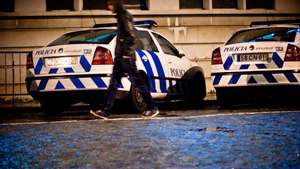Ontem a noite, voltei de carro a Lisboa, e reencontrei a cidade, como sempre, mobilada com semáforos, passadeiras, barreiras e sinais de trânsito — concebidos e instalados com a intenção de prevenir acidentes e, mais vagamente, ajudar as pessoas a chegarem aonde querem ir (mas só vagamente…).
Isso foi depois de uns dias a conduzir nas estradas do Parque Nacional da Peneda-Gerês, onde há uma falta quase total de tais medidas de segurança.
Mas, tanto quanto eu desse por isso, ninguém morreu.
Imaginem as estradas das serras de Peneda ou do Gerês. O vosso destino fica no outro lado do vale, a um quilómetro de distância em linha recta. Mas a estrada para lá chegar multiplica por dez ou vinte vezes essa distância, serpenteando pelos contornos da montanha, com curvas violentas, seguindo provavelmente um velho trilho entre aldeias. Tem pouca sinalização, não há indicação de limites de velocidade, e quase não existe uma única barreira entre o condutor e a morte eventual no fundo de um vale esquecido. Há vacas e cavalos selvagens por detrás de muitas curvas, e rochas espalhadas pelo alcatrão, tudo sem aviso. Para tornar as coisas mais difíceis, este mês há milhares de jovens em carros potentes a conduzir pela montanha, daqueles que gostam de ultrapassar os outros antes de uma curva apertada por cima de um precipício — sem ninguém para lhes dizer que abrandem. É Agosto, e por isso toda a população portuguesa emigrante em França (ou pelo menos, parece que é a população toda) está de volta, acompanhada pela segunda e terceira geração, atafulhando as estradas do Norte do país com automóveis e hábitos de condução franceses misturados com os hábitos antigos portugueses… uma combinação que enche o coração de medo a quem já uma vez conduziu num ou noutro desses países.
Mas ninguém morreu.
Imaginem rios que correm através de fissuras na montanhas, e que criam cascatas e lagos de água gelada, onde os seres humanos são naturalmente tentados a ir refrescar-se nos dias de 35ºC. Ora, é impossível chegar a estes oásis sem passar por matos espessos, terrenos pedregosos e declives escorregadios. No entanto, quando fui à Portela do Homem ou à Cascata do Arado, a serra parecia cheia de gente, entre jovens e velhos, todos vestidos de fato de banho, a escalar penhascos impossíveis, a descer a precipícios assustadores, como cabras montesas de chinelos, e a gritar uns para os outros “ANDA, caralho!!” — porque não há ninguém para lhes dizer que não.
Na maior parte do parque, não há rede de telemóvel, além de uma pitada de GPS. Podemos adivinhar onde estamos, mas se alguém partir o pescoço, ninguém vai conseguir enviar uma mensagem para chamar socorros. Nunca parei de pensar nisso enquanto via famílias inteiras a passar ao lado, nestes trilhos impossíveis, com bebés de colo e grandes cestos de piquenique.
Mas ninguém morreu.
Pergunto-me se de facto faz muita diferença, em sítios menos selvagens do que a serra do Gerês, dizerem-nos a toda a hora o que devemos fazer e não fazer. Pergunto-me se o facto de recebermos tantas instruções a cada momento não nos torna mais estúpidos e menos cuidadosos. Com tantos sinais, tantas linhas e tantas instruções, em vermelho, branco e amarelo fluorescente, a dirigir-nos e a dar-nos um sentido falso de segurança, provavelmente concentramo-nos menos, pensamos menos, prestamos menos atenção ao que nos rodeia, incluindo às pessoas e aos animais que podemos esmagar.
Levando isto à sua conclusão lógica: se as pessoas pudessem atravessar a estrada onde e quando lhes apetecesse, como se fossem vacas ou cavalos da montanha, talvez acabássemos, naturalmente, por conduzir com muito mais cuidado. Ninguém quer matar nem ser morto por acidente. Mas há muitas pessoas, sim, que querem quebrar as “pequenas” regras para desafiar a autoridade, tal como há, também, muitas pessoas que deixam depender a sua segurança de umas sinalizações apenas porque foi a autoridade que montou essas sinalizações.
Na montanha, passei muitas horas assustadoras, gritando muitas palavrões, a conduzir na faixa exterior de estradas estreitas, com uma queda no lado direito de 100 e mais metros, enquanto dezenas de outros carros avançavam na outra direcção, pelo lado interior, longe do precipício. Não há salva-vidas, não há cartazes que digam “não se pode divertir aqui”, não há quase nenhumas barreiras contra as quedas… nada, além da adrenalina e da sensação de auto-preservação de que todas as pessoas precisam naturalmente para se manterem vivas.
Adorei cada minuto.
E ninguém morreu.
(traduzido do original inglês pela autora)
Mountain Goats with picnics
Last night, I drove back into Lisbon, full of its street furniture of lights, crossings, bollards, barriers and signs intended to stop people getting killed and to vaguely help people find where they’re going (but only vaguely).
This after a few days driving about in the Peneda-Gerês National Park, which boasts almost a total lack of safety measures.
And nobody died.
Imagine the roads of Peneda-Gerês. Look across a valley to where you are going, which might be just a kilometre as the crow flies, and then spot the road that will take you there that is ten or twenty times as long, snaking around the mountain’s contours. Violently winding roads, most of which aren’t main arteries through the mountain, but old trails from one village to the next, have scant signage, no speed limit signs, and barely a barrier between you and certain death at the bottom of a long forgotten valley. There are longhorn cattle and wild horses around many corners, and recent rockfalls scattered across the tarmac. Add to that thousands of young men and women in powerful cars driving up and down the mountain with no one to tell them to drive more slowly, who like to overtake slower cars just before a tight bend that sits over a precipice. It’s August, so the entire (it seems) population of Portuguese emigrés in France are home, bringing with them their second and third generations, filling the roads of the North with French cars and French and Portuguese driving habits, a combination that will fill you with fear if you have ever driven in either country. And nobody died.
Imagine rivers that run through deep grooves in the hills, between vast boulders and rocks, creating beautiful rock pools and waterfalls, creating oases in the mountains where humans can go and cool off in the 35ºC heat, in icy freshwater straight from the source. These oases are impossible to get to without picking your way through undergrowth on slippery, sharp, dangerous routes, and yet they are filled with people, throwing themselves at the place. Very young to very old, clambering through woodland and rivers and rocks, in swimwear, climbing up and over and down horrific deadly paths, like mountain goats in flip flops, calling out “ANDA, caralho!” to each other, and diving into the rock pools from three metres up because they can. In most of the park, there is no phone signal but a mere scraping of GPS, so you might be able to work out where you are, but you wouldn’t be able to tell anyone that useful fact if you have broken your neck falling from a cliff, because there’s not even enough signal to send a text message. I thought about that as my family and I struggled down a difficult track in the middle of nowhere… alongside tiny babies in arms and huge picnic baskets. And nobody died.
It does make one question how much of a difference it makes to be told what we should be doing all of the time in less barren landscapes than this. I often wonder if being given instructions at every turn makes us more stupid, more reckless, makes us concentrate less, think less, pay less attention to our surroundings, including people and animals that we might squash, because there are big red and white and fluorescent yellow lines, signs and instructions that we have to follow and that give us a false sense of security.
Taking it to its logical conclusion, if people were allowed to cross roads anywhere at any time, as if they were longhorn cattle happily wandering about, maybe we would end up expecting them and would naturally drive or cross the road more carefully. No one wants to kill or be killed by accident. An awful lot of people, however, do want to break small rules, to stick it to “the man” and conversely and equally dangerously, an awful lot of people hang their security on a signpost, because “the man” put it there.
I spent many terrifying hours, swearing excessively and loudly, as I drove up the outside of narrow roads with a 100m drop to my right, as dozens of other cars sped down, smugly on the other side of the road, away from the precipice. There are no lifeguards, no “fun prohibited” signs, almost no crash barriers or bollards… nothing except everyone’s own adrenaline and sense of self-preservation to keep them alive.
I loved every minute of it.
And nobody died.













